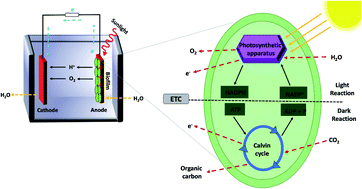Evaluation of photoanode materials used in biophotovoltaic systems for renewable energy generation†
Abstract
Biological photovoltaic (BPV) cells are living solar panels capable of producing clean energy by extracting electrons from sunlight (in daytime) and stored carbon in microbial cells (during the night or on cloudy days), irrespective of the organic substrate supply. The physicochemical properties of anode surfaces harbouring microbial communities in BPV systems influence the electrochemical charge transfer rate at the electrode. Hence, these properties play a significant role in regulating the kinetics of metabolic reactions in the biotic compartment while providing an electron transfer path. Various electrically conductive materials have been explored as solid-state anodes to improve the power output and economic viability of BPV systems. However, the current systems still suffer from low power density due to electrodes' electrochemical limitations and a lack of systematic optimization of the device. This review provides a comprehensive insight into the recent developments in different anode materials, their dimensional structure, and their impact on the performance of BPV systems in the last two decades. Moreover, the existing limitations of electrode materials in BPV systems are summarized, and outlooks for future anode advancements are foreseen.

- This article is part of the themed collection: Sustainable Energy and Fuels Recent Review Articles


 Please wait while we load your content...
Please wait while we load your content...